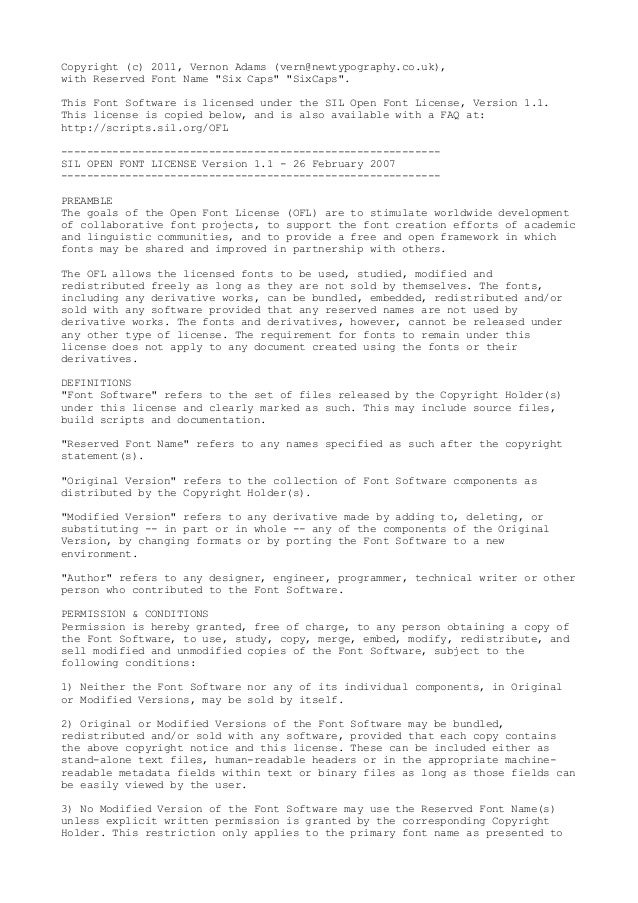Use of an OFL font in a logotype. Ask Question Asked 4 years, 1 month ago. Active 3 years. Which font license should I buy for use in a company logo? How do I properly create a derivative work with a font licensed as SIL Open Font? Make sure you look up the license of any font you want to distribute. Most commercial fonts, even if freely distributed, will not allow you to modify or rename the font. On the other hand, the SIL open font license (OFL) is probably as liberal as you can find. From its website.
| Author | SIL International |
|---|---|
| Latest version | 1.1 |
| Published | November 2005 |
| DFSG compatible | Yes[1] |
| Yes[2] | |
| Yes[3] | |
| Copyleft | Yes[2] |
The SIL Open Font License (or OFL in short) is a free and open source license designed for fonts by SIL International for use with many of their Unicode fonts, including Gentium Plus, Charis SIL, and Andika.[4] The Open Font License was first released in November 2005, six months after the GPL Font exception was released.
The license is considered free by the Free Software Foundation, which states that a simple hello world program is enough to satisfy the license's requirement that fonts using the license be distributed with computer software when selling them.[2] The Debian project agrees.[1]
Sil Open Font License Ofl
Terms[edit]
The Open Font License is a free software license, and as such permits the fonts to be used, modified, and distributed freely (so long as the resulting fonts remain under the Open Font License). However, the copyright holder may declare the font's name as being a 'Reserved Font Name', which modified versions then cannot bear (this includes subsetting for web fonts). The License permits covered fonts to be freely embedded in documents under any terms, but it requires that fonts be packaged with software if they are sold.Open-source fonts are a popular choice among designers. Most open-source fonts utilize the Open Font License (or OFL) by SIL international. The only stipulation is that anyone cannot charge others to use them.
Intention[edit]
The intent is to keep people from making money by simply redistributing the fonts. The only people who ought to profit directly from the fonts should be the original authors, and those authors have kindly given up potential direct income to distribute their fonts under the OFL.
See also[edit]
References[edit]
- ^ abThe DFSG and Software Licenses
- ^ abcFSF: Licenses for Fonts
- ^http://opensource.org/licenses/OFL-1.1
- ^SIL Open Font License definition from scripts.sil.org
Ofl License
External links[edit]
| Author | SIL International |
|---|---|
| Latest version | 1.1 |
| Published | November 2005 |
| DFSG compatible | Yes[1] |
| Yes[2] | |
| Yes[3] | |
| Copyleft | Yes[2] |
Sil Open Font License
The SIL Open Font License (or OFL in short) is a free and open source license designed for fonts by SIL International for use with many of their Unicode fonts, including Gentium Plus, Charis SIL, and Andika.[4] The Open Font License was first released in November 2005, six months after the GPL Font exception was released.

The license is considered free by the Free Software Foundation, which states that a simple hello world program is enough to satisfy the license's requirement that fonts using the license be distributed with computer software when selling them.[2] The Debian project agrees.[1]
Terms[edit]
The Open Font License is a free software license, and as such permits the fonts to be used, modified, and distributed freely (so long as the resulting fonts remain under the Open Font License). However, the copyright holder may declare the font's name as being a 'Reserved Font Name', which modified versions then cannot bear (this includes subsetting for web fonts). The License permits covered fonts to be freely embedded in documents under any terms, but it requires that fonts be packaged with software if they are sold.Open-source fonts are a popular choice among designers. Most open-source fonts utilize the Open Font License (or OFL) by SIL international. The only stipulation is that anyone cannot charge others to use them.
Intention[edit]
The intent is to keep people from making money by simply redistributing the fonts. The only people who ought to profit directly from the fonts should be the original authors, and those authors have kindly given up potential direct income to distribute their fonts under the OFL.
See also[edit]
References[edit]
- ^ abThe DFSG and Software Licenses
- ^ abcFSF: Licenses for Fonts
- ^http://opensource.org/licenses/OFL-1.1
- ^SIL Open Font License definition from scripts.sil.org